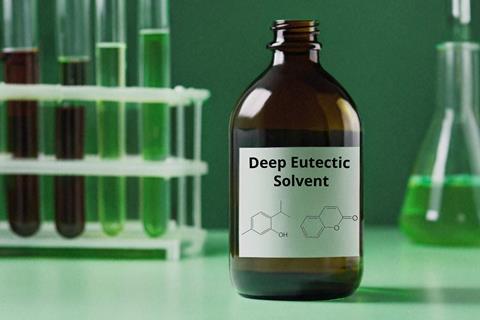
Natural deep eutectic solvents can be used to produce an interesting biosurfactant in a more sustainable way without organic solvents, Antwerp researchers write in the European Journal of Organic Chemistry.
Mannosylerythritol lipids (MELs) form a potentially green and circular class of biosurfactants, molecules with biomedical and cosmetic applications, among others, that have a hydrophilic head and a hydrophobic tail. Green and circular because they can be made from vegetable oil using microorganisms.
So far, this has been done in organic solvents, but researchers at the University of Antwerp wanted to know if it could be done just as efficiently in natural deep eutectic solvents (NADES). Attila Kovács, a postdoctoral researcher in the Intelligence in Processes, Advanced Catalysts and Solvents (iPRACS) group, is the winner of the Best Research Article by an Early Career Researcher award for this work.
MELs come in different forms, with more or less acetyl groups on the mannosyl moiety. Ideally, you want to use MEL without acetyl groups (called MEL-D). If you have MEL with acetyls, they can fall off, which not only changes the chemistry of the MEL, but also forms the smelly acetic acid, which is not really desirable for a skin care product.
The problem is that the MELs produced by microorganisms are mainly double-acetylated MELs (MEL-A), with some monoacetyl MELs (MEL-B and MEL-C). You can remove these acetyls with a lipase in the organic solvent 2-ethylhexanol and this works quite well, but a greener alternative might be NADES.
NADES are deep eutectic solvents, viscous liquids formed from mixtures of natural (waste) sources such as ammonium salts, sugars, acids and so on. Separately, these substances are often solid, but when mixed they form a thick liquid due to the high number of hydrogen bonding interactions between them. The Antwerp researchers compared the deacetylation of MELs in different NADES with the organic solvents 2-ethylhexanol and toluene.
From their experiments, the NADES thymol-coumarin and menthol-thymol emerged as good alternatives to the two organic solvents, with similar yields. About 50 percent of the MEL mixture is converted to MEL-D. The biggest problem with all methods is still the conversion of MEL-A. One of the two acetyls comes off easily, but the second one sticks.
NADES are therefore a good and particularly sustainable alternative to 2-ethylhexanol, but there is certainly room for improvement.
Cassimon, J. et al. (2024) EurJOC 27(7), DOI: 10.1002/ejoc.202300934












Nog geen opmerkingen